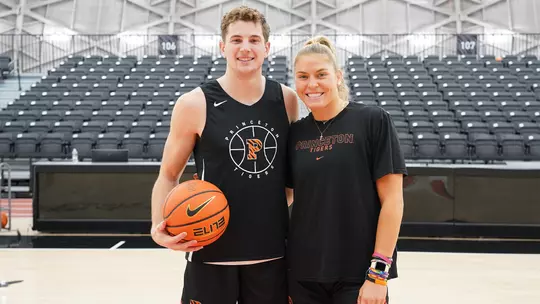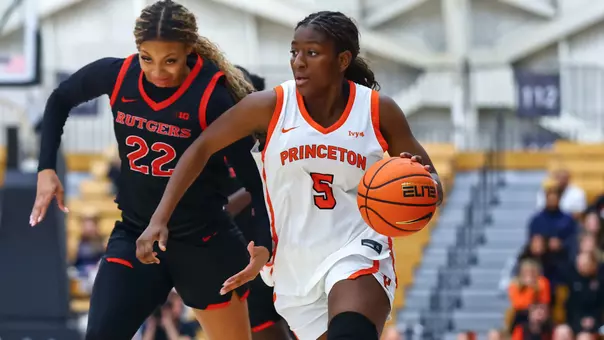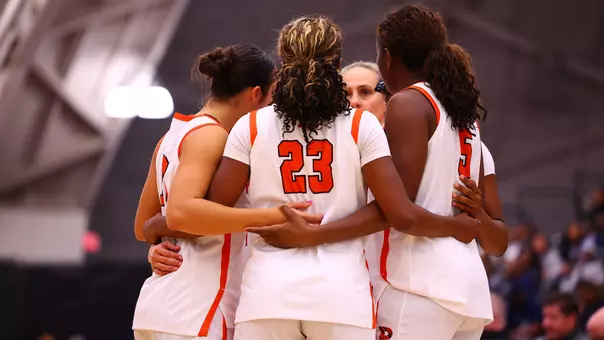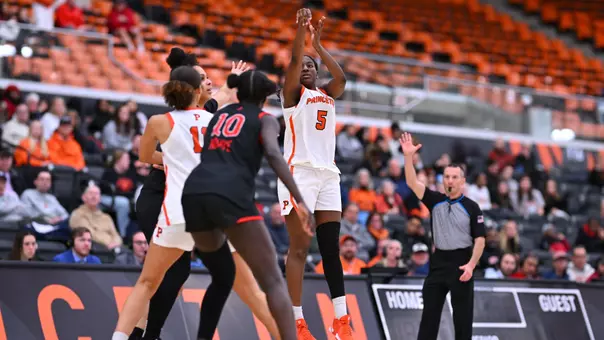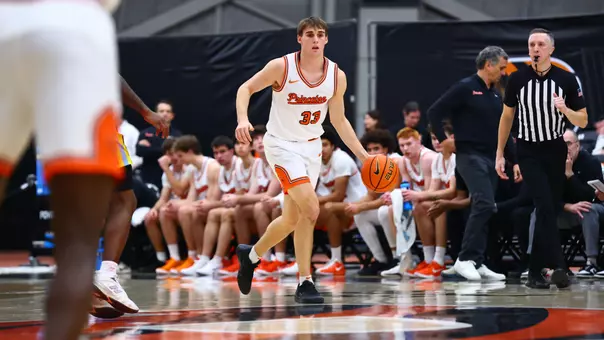Princeton University Athletics
Feature Story: On The Rebound
December 19, 2023 | Men's Basketball, Women's Basketball
Xaivian Lee started his drive to the basket. Out on the wing, in front of the Princeton bench, stood Caden Pierce, watching. There were 12 seconds to play in Princeton’s game against Furman. The Tigers were down two. Jadwin Gym was loud.
It was quite a contrast from 48 hours earlier. This time, Pierce was sitting up in the orange seats of the balcony in a nearly empty Jadwin. He was talking about what he does so well, perhaps better than anyone else who has ever played men’s basketball — emphasis on the “men’s” — at Princeton: Rebound.
“You have to assume,” he said in the stillness, “that every shot is a going to be a miss.”
Did those words go through his head as he watched Lee head into the lane? Or is it just something so innate that it just happens?
Either way, as Lee put his shot up, Pierce had already drifted below the three-point line and into the paint. As the ball rattled off the rim, Pierce was being shoved in the back, enough to throw him off balance but not enough to draw a foul. Despite the fact that he was now almost completely under the basket, he was able to rise up between two purple jerseys, grab the ball with two hands, land on one foot to avoid going out of bounds and then drill a pass to an open Matt Allocco, who canned the game-winning three-pointer with 4.2 seconds to play.
Moments later, Allocco was on a headset for an ESPN+ postgame interview, in which he said that “Caden Pierce made the play of the game.”
A few hundred miles away, Ellie Mitchell was on a bus with her Princeton women’s basketball teammates. She echoed what Allocco said. “The play of the game,” she said. Actually, that’s not all she said.
“Rebounds win games.”
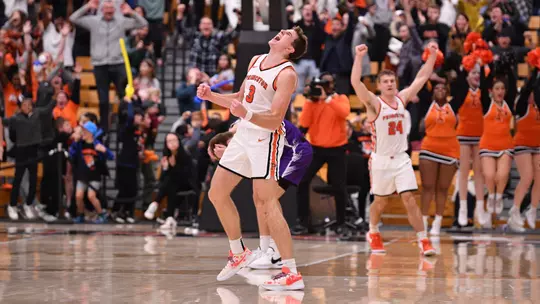
If anyone knows about that, it’s Mitchell. If Pierce is perhaps the best rebounder the men’s program has known, the same is true of Mitchell for the women. Between them, they have brought a dimension to Princeton basketball that hasn’t exactly been a staple through the years.
Of the top seven rebounders in Princeton men’s basketball history, six of them played their final game as a Tiger in 1974 or earlier. The only exception is Ian Hummer, a 2013 grad, who ranks fifth. The only Princeton player who was known more for his rebounding than anything else in the last 50 or so years was Mason Rocca, and injuries prevented him from having the kind of career he otherwise might have as a Tiger.
Former men’s coach Bill Carmody, in 1996, was asked about his team’s offense. He said: “It’s the shoot and run. One player shoots. Everyone else runs back on defense.”
The Princeton women’s record for rebounds in a career is 1,099, held since 1978 by Margaret Meier. The men’s record is 1,008, by Bill Bradley, who graduated in 1965. Whitey Fulcomer (995, graduated 1958), Bella Alarie (964, graduated in 2020) and Ellen DeVoe (942, graduated in 1986) comprised the entirety of Princeton basketball players with at least 900 career rebounds before Mitchell joined the club earlier this season (she currently has 948).
How are these for numbers?
Mitchell, a senior, has 44 double-figure rebounding games in her career, as well as four of the top nine single-game rebounding totals in program history. Pierce, a sophomore, has 15. The 59 they have between them are more than Princeton men’s basketball had for the entire decade of the 1980s and the entire decade of the 1990s combined.
Pierce had 16 rebounds in the second round of the NCAA tournament last year, a win over Missouri that vaulted Princeton into the Sweet 16. Mitchell had 18 of her own in the team’s second-round loss to Utah last March. She has twice had at least 22 rebounds in a game and recently had 19 in a win at Villanova.
Should they maintain their current paces, Mitchell would be the all-time leading rebounder in Princeton women’s basketball history and Pierce would be the all-time leading rebounder in Princeton men’s basketball history.
“When you get a rebound on the side with the other team’s bench, you can hear them chirping at their player who should have boxed you out,” Mitchell says. “Or you can hear their coach chew them out. You see the other team drop its shoulders. I can feel that, and it definitely fuels me.”
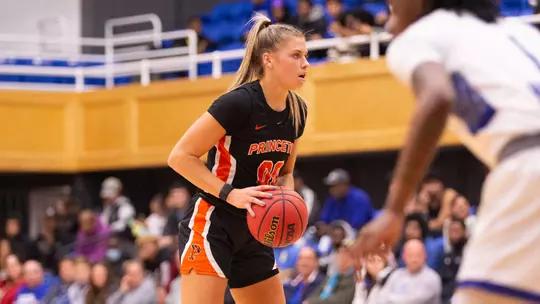
What's fascinating is that talking to one is pretty much like talking to the other. It’s eerie how much they have in common and how much they say the same things.
Neither one is the tallest player on the court. They both talk about the importance of positioning and movement to get to loose balls. They both, independent of each other, say that bigger players take rebounds for granted, using those exact words.
Both credit the fact that they’re the youngest with only older brothers for toughening them up. Both say they never modeled their games on anyone else but then both throw the name Dennis Rodman out there.
Both are endless scratches and bruises. Rebounding, after all, is about effort as much as it’s about anything else, and that often involves floor burns and wrestling matches.
“Ellie says that some people just have a knack for rebounding,” Pierce says. “I just try to be the guy everyone hates playing against. I want to be the guy where during a timeout, the other team is saying ‘somebody has to take care of that guy.’”
Pierce grew up outside of Chicago, in the town of Glen Allyn. His parents were both athletes at Northwestern, his father in football and his mother in volleyball. He has two older brothers: Justin, who played basketball at William & Mary and then North Carolina and who now plays in Europe, and Alec, a wide receiver for the Indianapolis Colts who was a second-round draft pick out of Cincinnati in 2022 and who has caught 66 passes for 984 yards in his first two seasons.
You want to try to get a rebound away from them when you’re a little kid?
“My brothers are four and six years older than I am,” Pierce says. “When I was growing up, I wasn’t close enough in age where I could compete physically. Whatever they wanted to do to me, they did to me. It was brotherly love and brotherly competitiveness that shaped me into who I am today. It was a constant battle. That’s what older brothers are there for. The youngest brother has to have the toughest skin and be the grittiest. We never got seriously hurt, but I’m sure my mom was ripping her hair out.”
Mitchell grew up in Chevy Chase, Md., and attended D.C. power Georgetown Visitation. She has three older brothers, including a twin — “he’s a minute older than I am, but that still counts as older.” One of her older brothers, Colin, is 6-8 and played at Washington & Lee.
Both Mitchell and Pierce played almost every sport there was growing up. Pierce finished fourth in the state in golf his senior year. Mitchell played on her brother’s baseball team and could have played college lacrosse.
Basketball, though, was their best. Mitchell showed an early penchant for rebounding, and her family used to call her “Denise Rodman” when she was younger. She stands 6-1, which in the world of college women’s basketball rebounders is not tall.
“I realized that if I was going to get the ball, I had to move for it,” she says. “The really tall players, they take their space for granted. They’re not necessarily working as hard under the basket, and they’re not expecting you to move a lot. I try to use that to my advantage.”
“Ellie says that some people just have a knack for rebounding. I just try to be the guy everyone hates playing against. I want to be the guy where during a timeout, the other team is saying ‘somebody has to take care of that guy.’”Caden Pierce
As a freshman, it took Mitchell four games to reach double figures in rebounds for the first time, and that came with 10 against a Florida Gulf Coast team that was nationally ranked at the time. She took the gap year in 2020-21 and came back in 2021-22 by earning the first of her two Ivy League Defensive Player of the Year Awards. She also ended the season with double figures in seven of the last eight games, including 15 in the second round of the NCAA tournament that year.
Also during her sophomore year she became the first Princeton women’s basketball player ever to have more than 300 rebounds in a season, finishing with 311. She bettered that number last year with 338 while finishing ninth in Division I in rebounds per game with 11.3. She’s led the Ivy League in rebounds per game each of the last two years and leads again this year. In her four NCAA tournament games to date, she’s averaged 13 rebounds.
“Rebounding is about work,” she says. “The dirty work, that’s the role I get to play. That’s what I have fun doing.”
Pierce, who is listed as 6-7, was the Ivy League Rookie of the Year last year, and he’s been a two-time Ivy Player of the Week so far this season. At his current scoring and rebounding paces, he’d finish his career way past 1,000 in both categories. Here’s the list of Princeton men’s players who have ever done that: Bill Bradley.
“There are physical components to rebounding,” Pierce says. “There’s size and athleticism. Wingspan. Those positive affect rebounding. But you can be the biggest guy and not be the best rebounder. You don’t need to be 6-10. You can be a 6-6 wing guy and be the best rebounder. Big guys? They take it for granted. A guy who typically isn’t supposed to get rebounds takes pride in it.”
Both he and Mitchell are great offensive rebounders. Their instincts are to go get the ball but not necessarily to go right back up with it; instead, as was the case on the winning play against Furman, they look for open teammates at a time when everyone is out of position. This is one of the disadvantages of being an undersized rebounder.
“Offensive rebounds are backbreakers,” Pierce says. “Most of the time, I look out to the perimeter after I get the ball. I’m not usually in a position to go right back up right away. And good shooters are most comfortable when they get the ball from right under the rim. That’s how you practice, right? Somebody is rebounding for you and feeding it back to you.”
Pierce’s explosive leaping ability is obvious to anyone who watches him play (and is even more impressive considering his first dunk came as a high school senior). He also is strong, a product of the weightroom and the physical development of growing into his body. The combination of those two qualities enables him to get most of his boards with two hands.
“Coach [Mitch] Henderson was recruiting me and showing me film of one of my AAU games,” Pierce says. “The first thing he showed me was a rebounding ciip. He paused it when I had both hands above the rim. He said he tries to get all of his guys to do that. I’m not sure why I go up with two hands. Most people don’t do that.”
“Rebounding is about work. The dirty work, that’s the role I get to play. That’s what I have fun doing.”Ellie Mitchell
It’s hard to imagine there was anything more that Pierce could have asked for out of his freshman year. He was an opening day starter who had 10 rebounds in that game (against Hofstra), and he just kept going from there. By the end, he’d averaged 8.3 points and 7.2 rebounds and was part of the maddest March Princeton basketball has ever seen from its two teams.
On four successive days, Princeton played in an NCAA tournament game, first the men over Arizona in Sacramento, then the women over North Carolina State in Utah, then the men over Missouri to get to the Sweet 16 and then a tough loss for the women to the host Utes.
Arizona was the No. 2 seed in the region. Princeton was the No. 15. Arizona started one 7-0 player and one 6-11 player.
“It was hard not to look across the court during layup lines and not think ‘these guys are huge,’ but it was fun to be the underdog,” Pierce says. “At the end of the day, we had nothing to lose, and that perspective allows you to just go out and play and whatever happens happens. That sense of freedom makes it easy not to be intimidated.”
Matched up against the giants, Pierce still had eight boards in the game, as well as six points, two of which came on the clinching free throws. Two nights later, he had nine points and 16 rebounds as Princeton ran Missouri off the court to reach the Sweet 16.
As for the women, they defeated N.C. State 64-63 on Grace Stone’s late three-pointer. Stone and Kaitlyn Chen finished with 22 each in that game. This is what one postgame story had to say:
The most important player, though, had to be Ellie Mitchell. She simply willed the team to find more energy, to keep upping the defensive intensity, to track down every loose ball. Her final stat line: four points, 11 rebounds, four blocked shots, five steals. What you can't measure is the impact she had on everyone else.
The Tiger run ended one round later, despite the 18 rebounds Mitchell had against Utah. Still, that’s two NCAA wins in two years for the women.
“It was great that both teams could go and perform and put ourselves on the map,” Mitchell says. “I think we both made some impact statements with our games. I know we weren’t shocked. We see the work we put into it each day. It was a lot of fun, and there was so much emotion. I was just super excited for the men. It was definitely a fun March.”
“It’s unbelievable,” Pierce says from the orange seats. “In a gym like this, with so many banners, we’ll always be able to look up and remember the journey we had. It’s just amazing.”
Not far from where Pierce stood after the ball was inbounded against Furman, the words “Pete Carril Court” are etched on the playing floor. This is more than just Pete Carril’s court, though. His legacy will always be a part of Princeton basketball, even if he hasn’t coached here since 1996, when Henderson was a sophomore. Pierce never had a chance to meet him before Carril passed away in the summer of 2022.
“This isn’t the same kind of Princeton team,” Pierce says. “This is a much different era. But it’s the same program. There’s a lot of the same fundamentals. There are roots that run very deep here.”
Carril was famous for so much of what he said. Among his better lines was this: "A person's rebounding ability is inversely proportional to his home's distance from the railroad tracks."
So what would the Hall of Fame coach have made of this, from before a recent Princeton game, when a spectator walked into Jadwin and was overheard to say “I’m here to see Caden Pierce rebound.”
He would have smiled a wry smile. After all, he also said this:
Light bulbs, that's what I call them. Light bulbs. There's an intangible feeling a coach and a player have that you can delight in. I call them light bulbs. They walk on the floor, the light goes on."
Carril said that in 1991, long before Mitchell or Pierce was born.
How did he know he was talking about them, then?
— by Jerry Price
